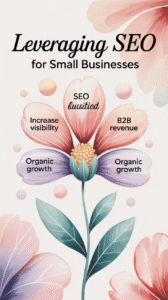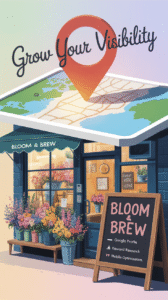
In today’s competitive market, small businesses need smart marketing strategies that are affordable. Free marketing can be just as powerful as paid ads. Organic leads convert at 14 times the rate of paid ads.

Social media is a big player, with 93% of marketers using it and 4.7 billion people active on social media. SEO is a game-changer for B2B companies, bringing in 70% of their revenue. By using the right organic marketing strategies, small businesses can grow a lot. For a detailed guide on organic marketing, check out StoryChief’s Ultimate Organic Marketing Guide.
Key Takeaways
- Leverage SEO to increase online visibility
- Utilize social media channels for organic growth
- Create effective lead magnets to capture audience interest
- Implement email campaigns to nurture leads
- Engage in digital PR to build brand reputation
The Power of Organic Marketing for Today’s Small Businesses
For small businesses with a tight budget, organic marketing is a great choice. It’s cheaper than paid ads. It’s about making and sharing content that people find valuable and interesting.
Why Free Marketing Matters in a Paid Advertising World
In a world where ads are everywhere, organic marketing stands out. It helps small businesses earn trust and respect without spending a lot. By using organic marketing techniques, they can grow their online presence and increase sales.
Setting Realistic Expectations and Measuring Success
To do well in organic marketing, small businesses need to be realistic and track their progress. They should watch key performance indicators (KPIs) to see how well their marketing is working.
Key Performance Indicators for Organic Marketing
Important KPIs for organic marketing include:
- Website traffic
- Social media engagement
- Email open rates
- Conversion rates
By keeping an eye on these KPIs, small businesses can improve their marketing plans. This leads to better results over time.
Content Marketing: Creating Value That Converts Visitors to Customers
Content marketing is a key tool for small businesses. It helps them build a strong online presence without spending a lot on ads. By making and sharing valuable content, businesses can draw in and keep a specific audience.
Developing a Content Strategy Aligned With Business Goals
A good content marketing plan starts with knowing your business goals and who you’re trying to reach. You need to find what makes your business special and create content that speaks to your audience. For more tips, check out Semrush’s guide on content marketing for small businesses.

Blog Posts, Videos, and Podcasts: Choosing Your Content Mix
The content you make should match what your audience likes and what you want to achieve. Blog posts are good for SEO, while videos and podcasts offer a more personal touch. Mixing these types can help you reach more people.
Content Calendar Creation for Consistent Publishing
Being consistent is crucial in content marketing. A content calendar helps you plan and schedule your content ahead of time. This way, you can keep a steady publishing schedule. There are many tools to help you do this.
Tools for Content Planning and Creation
Tools like Trello, Asana, and Google Calendar are great for planning your content. Canva and Adobe Creative Cloud can also help you make high-quality visual content.
Local SEO: Dominating Your Geographic Market

Small businesses can thrive without a big ad budget by using local SEO. This strategy makes them show up in local search results. It brings in more foot traffic and sales.
Google Business Profile Optimization Techniques
Getting your Google Business Profile right is key for local SEO. You need to claim your listing and verify your location. Make sure your profile is filled with the latest info, like hours and contact details.
High-quality photos of your business can also make your profile stand out. This can attract more customers.
Local Keyword Research and Implementation
Doing deep local keyword research is vital. It shows what people in your area are looking for. Google Keyword Planner can help find these keywords.
Once you find them, use these keywords in your website’s content and tags. This makes your site more relevant to local searches.
Building Local Citations and Backlinks
Getting local citations and backlinks can boost your search rankings. List your business in local directories. Also, work with other local businesses for promotions.
Mobile Optimization for Local Searches
Most local searches happen on mobile devices. So, it’s crucial that your website works well on phones. A mobile-friendly site improves user experience and boosts sales.
| Local SEO Strategy | Description | Benefits |
|---|---|---|
| Google Business Profile Optimization | Claim and optimize your Google Business Profile | Increased visibility in local search results |
| Local Keyword Research | Identify and use relevant local keywords | Better targeting of local customers |
| Local Citations and Backlinks | Build citations and backlinks from local sources | Improved local search rankings |
A local SEO expert says, “Local SEO is not just about being found online; it’s about being found by the right people at the right time.” By using these strategies, small businesses can win in their local markets without spending a lot on ads.
“The key to successful local SEO is consistency and accuracy across all online platforms.”
Email Marketing: Building Direct Customer Relationships
For small businesses, a solid email marketing plan is key. It helps build direct ties with customers. Through email, businesses can share important content and boost sales without ads.

Growing Your Email List Without Paid Ads
To grow an email list naturally, you need to be creative. Offer free resources like eBooks or webinars. Make sure your website has clear calls-to-action (CTAs) to capture visitor info.
Segmentation Strategies for Higher Engagement
Segmenting your email list makes your messages more relevant. This way, you can send content that really speaks to each group. It boosts engagement and makes your emails more effective.
Automated Sequences That Nurture and Convert
Automated emails can guide leads through the sales process. They send timely, relevant messages based on actions like signing up for a newsletter. This helps move subscribers closer to making a purchase.
Email Analytics: What to Track and Why
It’s crucial to track the right email metrics. Look at open rates, click-through rates (CTRs), conversion rates, and unsubscribe rates. By analyzing these, you can tweak your strategy to boost engagement and sales.
Social Media Organic Growth Tactics
For small businesses with no ad budget, social media is a great way to grow organically. It’s all about creating good content and engaging with your audience. Knowing where your audience hangs out is key.
Platform Selection Based on Target Audience
Picking the right social media platforms is essential. For example, Instagram and Pinterest are perfect for businesses with lots of visuals. LinkedIn is better for B2B companies.
Content Strategies for Each Major Platform
Every social media platform needs its own content plan. Twitter is all about quick, timely posts. Facebook lets you share more in-depth content. Remember, content must fit the platform.
| Platform | Content Type | Posting Frequency |
|---|---|---|
| Visual, Stories | Daily | |
| Short-form, Timely | Multiple times a day | |
| Diverse, Detailed | At least 3 times a week |
Engagement Techniques That Build Following
Engagement is a two-way street. It’s not just about sharing your message. It’s also about listening and responding to your audience. Effective social media strategies include using hashtags, running contests, and collaborating with influencers.
Social Listening and Community Management
Social listening helps you keep up with trends and what your customers are talking about. By managing your community well, you can build a loyal following. You can also solve problems before they get big.
To wrap it up, growing organically on social media takes careful planning. You need to choose the right platforms, create the right content, and engage with your audience. With these strategies, small businesses can grow online without spending a lot on ads.
Organic Ways to Market Your Small Business Through Strategic Partnerships
Using strategic partnerships can help small businesses grow. By working together, businesses can use each other’s strengths. This helps them reach their goals.

Identifying Complementary Businesses for Collaboration
Finding the right partners is the first step. Look for businesses that offer what you don’t. For example, a company selling outdoor gear might team up with a hiking tour operator. This way, they can offer packages together.
Forbes says, “Strategic partnerships can help businesses grow. They can improve what they offer and stay ahead of the competition.”
“The key to successful partnerships is to find businesses that share your values and target audience.”
Joint Content Creation and Cross-Promotion
Creating content together is a great way to use partnerships. You can write blog posts, make videos, or host webinars. This helps you reach more people.
For instance, a fitness studio and a health food store could work together. They could make workout and nutrition plans. Then, they could share each other’s content on social media.
Measuring Partnership ROI
It’s important to see how well partnerships work. You can track things like website visits, new leads, and sales. This shows if the partnership is helping.
| Metric | Description | Example |
|---|---|---|
| Website Traffic | Number of visitors directed to your site through the partnership | 500 new visitors |
| Lead Generation | Number of leads generated through the partnership | 100 new leads |
| Sales | Number of sales resulting from the partnership | 20 new sales |
By choosing the right partners and making good content, small businesses can grow. They can use partnerships as a way to market for free. This also helps with their content marketing.
Customer Referral Programs That Drive New Business
One of the best organic ways to market your small business is through customer referral programs. These programs encourage current customers to bring in new ones. This is a smart way to grow your business without spending a lot.
Referral programs use the trust and happiness of your current customers. When a customer tells a friend about your business, the friend is more likely to trust you. This is because they got a personal recommendation.
Designing a Referral System That’s Easy to Use
A referral system needs to be simple and easy to understand. It should be clear how the program works and how customers can join.
- Clearly define the terms and conditions of the referral program.
- Provide multiple channels for customers to refer others (e.g., email, social media, in-app notifications).
- Ensure that the referral process is user-friendly and accessible on various devices.
Incentive Structures That Motivate Without High Costs
The success of a referral program depends on the incentives. The incentives should be appealing but not too expensive for your business.
Some good incentives include:
| Incentive Type | Description | Cost-Effectiveness |
|---|---|---|
| Discounts | Offer discounts on future purchases for both the referrer and the new customer. | High |
| Rewards Points | Implement a points system that can be redeemed for products or services. | Medium |
| Exclusive Services | Provide exclusive services or early access to new products for referrers. | Low |
Implementing and Tracking Your Referral Program
After designing your referral program, it’s important to put it into action and track its success. This means:
- Promoting the referral program through various marketing channels.
- Using analytics tools to monitor referrals and conversion rates.
- Adjusting the program based on feedback and performance data.
For more detailed strategies on growing your small business with referral programs, you can visit this resource.
Case Studies: Successful Small Business Referral Programs
Many small businesses have grown a lot thanks to referral programs. For example, a local boutique clothing store got 20% more customers in three months. They offered a discount to both the referrer and the new customer.
By learning from successful referral programs, you can attract new customers without spending a lot. This is a powerful way to use organic marketing to grow your business.
Content Repurposing: Multiplying Your Marketing Impact
Small businesses can greatly boost their marketing by repurposing content. This means turning old content into new forms to reach more people or to make a point stronger. It’s a way to get more out of content marketing without spending more, which is all about free marketing.
Transforming Blog Posts Into Multiple Content Formats
Changing blog posts into different formats is a smart move. For example, a long blog post can become an infographic, a video, or a podcast. This meets different people’s learning styles and gets your content seen on more platforms.
Distribution Strategies Across Platforms
After repurposing content, it’s key to share it on various platforms. You might post an infographic on Instagram, a video on YouTube, or a podcast on Spotify. Each platform has its own audience, and using the right strategy can make your content more impactful.
Efficiency Tools for Small Business Content Teams
Small businesses can use tools to make repurposing content easier. Tools like Canva for graphics, Lumen5 for videos, and Anchor for podcasts make creating different content types simpler. These tools save time and help ensure your content looks great.
Community Engagement and Local Marketing Initiatives
Getting involved in the local community is a great organic way to market your small business. By joining local events, sponsoring activities, and working with local media, you can boost your visibility and reputation without spending a lot on ads.
Becoming a Valued Local Business Leader
To be seen as a leader in your community, focus on helping others. You can sponsor sports teams, host charity events, or give free services to those who need them. These actions create goodwill and spread positive word-of-mouth.
Event Participation and Hosting Strategies
Being part of or hosting local events is a smart way to connect with people. You can organize workshops, seminars, or webinars on topics related to your business. This makes you a trusted expert and builds customer trust.
Building Relationships With Local Media
Working with local media can give your business valuable coverage and credibility. Contact local journalists and share your expertise or press releases about your community work.
Measuring Community Marketing Impact
To see how well your community marketing works, keep an eye on things like event attendance, social media mentions, and press coverage. This helps you know what’s effective and where you can improve.
Leveraging Customer Reviews and User-Generated Content
In today’s digital world, using customer reviews and content is key for small businesses. It boosts credibility and creates a community around the brand.
Systematic Approaches to Gathering Customer Feedback
Getting feedback from customers is vital. Effective strategies include:
- Implementing post-purchase surveys
- Using email follow-ups to solicit feedback
- Monitoring social media for customer comments and reviews
Showcasing Authentic Customer Stories
Real customer stories can make a brand more believable. Businesses can achieve this by:
- Sharing customer testimonials on their website
- Creating case studies that highlight customer success stories
- Featuring user-generated content on social media platforms
Responding to Negative Reviews Effectively
Dealing with negative reviews is crucial for a good brand image. Key strategies include:
- Acknowledging the customer’s concern promptly
- Offering a solution or compromise
- Following up to ensure customer satisfaction
Review Platforms That Matter Most for Small Businesses
For small businesses, some review platforms are more important. These include:
| Platform | Importance |
|---|---|
| Google Reviews | High |
| Yelp | High |
| Facebook Reviews | Medium |
By focusing on these areas, small businesses can use customer reviews and content well. This helps improve marketing and strengthens the brand.
Conclusion: Creating Your Integrated Organic Marketing Plan
As a small business owner, you now know how to grow without spending a lot on ads. The secret is to mix different marketing strategies into one plan. This plan should speak to your audience.
Use content marketing, local SEO, email, and social media to build a strong online presence. Get more people to talk about your business through referrals and partnerships. Also, engage with your community to reach more people.
Keep an eye on how well your strategies are working and make changes as needed. This way, you’ll get the most out of your efforts.
To make a good marketing plan, first figure out what you want to achieve and who you’re trying to reach. Create content that meets their needs, like blog posts, videos, and podcasts.
Make sure your Google Business Profile is up to date and get local citations to stand out in your area. Build an email list and send out automated messages to keep leads interested. By using these organic marketing methods, you can grow your business without spending on ads.
FAQ
What is organic marketing, and how does it differ from paid advertising?
Organic marketing attracts your target audience without paid ads. It’s about sharing valuable content to keep a defined audience interested. Unlike paid ads, organic marketing builds a loyal community through real interactions.
Why is content marketing a crucial aspect of organic marketing strategies?
Content marketing adds value to potential customers, making your brand a leader in your field. It attracts and nurtures leads, leading to sales. Good content builds trust and keeps customers coming back.
How can local SEO strategies benefit small businesses operating in specific geographic areas?
Local SEO helps small businesses stand out in their area by optimizing for location searches. This includes Google Business Profiles, local citations, and content for local searches. It boosts visibility, attracts local customers, and increases foot traffic.
What role does email marketing play in organic marketing, and how can it be effectively utilized?
Email marketing builds direct customer relationships. It involves creating engaging emails, segmenting lists, and using automated sequences. This nurtures leads and drives conversions, keeping your audience loyal.
How can social media be leveraged for organic growth, and what are the most effective strategies?
Social media is key for organic growth by sharing content that resonates with your audience. Choose the right platforms, create specific content, and engage with followers. This builds a loyal community, driving traffic and sales.
What are strategic partnerships, and how can they benefit small businesses through organic marketing?
Strategic partnerships help small businesses grow by working with complementary businesses. They expand reach, credibility, and drive new leads. Successful partnerships involve joint content, cross-promotion, and ROI tracking.
How can customer referral programs drive new business, and what are the key elements of a successful program?
Customer referral programs encourage satisfied customers to bring in new ones. A good program has an easy referral system, motivating incentives, and tracks referrals. This way, small businesses get new customers at a lower cost, boosting growth and revenue.
What is content repurposing, and how can it maximize marketing impact for small businesses?
Content repurposing turns old content into new formats, like videos or infographics. It refreshes marketing efforts, reaching more people and maximizing ROI. This approach saves costs and boosts efficiency.
Why is community engagement and local marketing important for small businesses, and how can they be effectively implemented?
Community engagement and local marketing build strong local relationships, fostering loyalty. Participate in events, build local media relationships, and measure impact. This makes small businesses leaders in their area, attracting and keeping customers.
How can customer reviews and user-generated content benefit small businesses, and what are the best practices for leveraging them?
Customer reviews and content build trust and credibility. Gather feedback, showcase real stories, and respond to negative reviews well. This drives conversions and boosts sales for small businesses.

